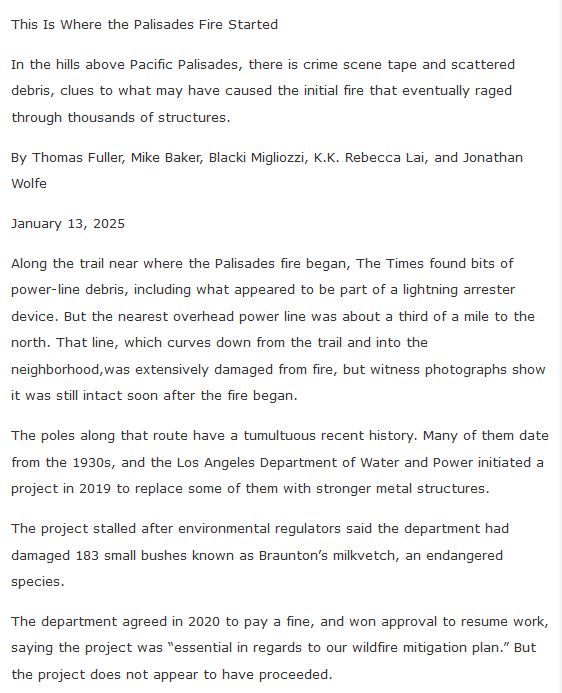
Posted on 01/16/2025 1:54:34 PM PST by grundle
Endangered species like Brauntons Milkvetch should be saved with captive breeding programs.
They should never be used as an excuse to stop fire mitigation, dams, reservoirs, power plants, housing, etc.
From the New York Times: https://archive.ph/Fv8d4
From the Los Angeles Times: https://archive.ph/zgpOj
Saving flowers is cute, but I’d rather focus on saving the people first.
Never.
Pay landowners under third party validated and insured stewardship contracts.
I post 3 to 5 articles a year. I give monthly as this is for free speech. FR is not letting me post. I guess they don’t want my money. Have tried through every option to post, even the smokey back room.
That’s better than being Brauntons Milkvetch.
“grundle” no intent to hijack your thread. I can’t do common interest welfare threads. Guess I hit home. F**k them. If the desk punks would actually meet my in the field... Oh, nevermind they send their disposables, who are our children. The desk jokies never nee fight, the politically connected ones. They should be first with parents.
I agree, and alternate locations they might be transplanted should also be considered

After 3 decades, one has to wonder just how endangered it really is.
Brauntons Milkvetch (Astragalus brauntonii) is a rare species of milkvetch known by the common name Braunton's milkvetch. It is a short-lived perennial shrub with lilac flowers that is typically found on carbonate soils in fire-prone areas. It is a pioneer species that usually appears in the aftermath of wildfires and other disturbances. It is known from fewer than 20 extant occurrences in the hills and mountains surrounding the Los Angeles Basin in Southern California, as well as an isolated population in northern Baja California.This plant, like many chaparral species, is fire-adapted and requires wildfire or other disturbance to propagate. The beanlike seeds require scarification to break down their tough seed coats before they can germinate. The seeds persist for years in the soil until fire allows them to sprout, with populations of the plant springing up in an area that has been recently swept by wildfire.
Source https://en.m.wikipedia.org/wiki/Astragalus_brauntonii
So, how did the “Milkvetch” make out with the raging fire.?
Was the area with the Brunton’s Milkvetch burned over in the fire?
Well, I guess that answered my earlier question.. :)
Morons, all of the endangered plants were burned up in the fires.
California Rare Plant Rank: 1B.1 (rare, threatened, or endangered in CA and elsewhere). Federal status: Endangered.
From this map, it looks likely some locations with Brunton’s Milkvetch were burned over, which to this native plant geek is probably the best thing that could have happened for it. Once it rains, the leachate from partially combusted organic matter which goes into the soil will contain karrikinolides, which in minute amounts will stimulate the production of gibberellic acid in seed, thus breaking seed dormancy. Heat also scarifies seed making germination more likley. If they get rain, it is likely to germinate. Whether it makes it to reproduction is another matter entirely.
What looks to me like has been done here is to deem a particular variant a "species" when such has not been biologically established. Usually political purposes are involved, in this case likely real estate interests. I'm going to quote for you the Jepson eFlora page for the genus. As you seem to have your wits about you Dean, I'll suspect you'll see what I'm saying between the lines of the quote.
Species In Genus: > 2500 species: +- worldwide (380 in North America, 97 in California, including many rare taxa). Etymology: (Greek: ankle-bone or dice, perhaps from rattling of seeds within fruit) Note: Difficult; flower and fruit needed for identification; fruit said to be "deciduous" dehisce only after fruit has separated from pl; many good species appear similar; some species complexes need study. Taxa near province boundaries may appear in > 1 key. Varieties keyed under species for simplicity; species with varieties so identified in key. Fruit length including beak and any stalk-like base unless fruit body specified; fruit depth is suture-to-suture axis. Astragalus tephrodes A. Gray var. brachylobus (A. Gray) Barneby in southwestern Utah, Arizona, near California.
Jepson eFlora Author: Martin F. Wojciechowski & Richard Spellenberg
Unabridged Reference: Barneby 1964 Mem New York Bot Gard 20:1--1188; Isely 1998 Native and Naturalized Leguminosae (Fabaceae) of the United States
No problem.
Make enough different “species” and you can shut down any location.
What gets to me is the damage done to adaptive genetic biodiversity by this kind of political and scientific corruption. There really are mass extinctions in progress, but for entirely different reasons than is commonly supposed. I wish I could do something about that motivational architecture, at least I gave that my best shot. Henry Lamb told me I was 50 years ahead of my time. He may have been right, but we're half way there!
Precisely my point: People aren’t designated as different species by hair color.
I took a course on nematodes ones. one method of classification was to cut off the ass ends, smash them on a slide and look at the patterns
I often thought that would be a good way to classify people. A few innovative people tried this with copy machines.
Disclaimer: Opinions posted on Free Republic are those of the individual posters and do not necessarily represent the opinion of Free Republic or its management. All materials posted herein are protected by copyright law and the exemption for fair use of copyrighted works.